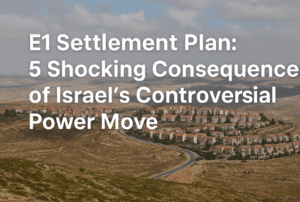E1 Settlement Plan: 5 Shocking Consequences of Israel’s Controversial Power Move
Israel’s decision to advance the E1 settlement project marks a pivotal escalation in its West Bank policies, aiming to cement territorial control by linking East Jerusalem to nearby settlements. Spearheaded by Finance Minister Bezalel Smotrich, the plan would construct thousands of housing units, severing the West Bank’s northern and southern regions and isolating Palestinian communities. Analysts warn this fragmentation—reminiscent of apartheid-era “Bantustans”—would render a contiguous Palestinian state impossible, undermining decades of international peace efforts.
The project, stalled since the 1990s due to global opposition, now proceeds amid accelerated settlement approvals and segregated infrastructure favoring settlers. Palestinians face deepened displacement, restricted movement, and economic isolation, while Israel prioritizes irreversible “facts on the ground” over diplomacy. Despite U.S. and EU condemnations, weak enforcement emboldens Israel’s unilateralism, leaving the two-state solution near collapse. The move challenges the world to confront a stark choice: meaningful intervention or acceptance of a one-state reality defined by inequality.

E1 Settlement Plan: 5 Shocking Consequences of Israel’s Controversial Power Move
The Israeli government’s decision to advance the long-stalled E1 settlement project has reignited fears of permanently extinguishing prospects for a Palestinian state. Spearheaded by Finance Minister Bezalel Smotrich, the plan aims to construct 3,412 housing units east of Jerusalem, linking the settlements of Kfar Adumim and Maale Adumim to the city. Analysts warn this move could bisect the West Bank, entrenching Israeli control over occupied territory and isolating Palestinian communities.
Why E1 Matters: Geography and Fragmentation
The E1 corridor’s strategic location is key to understanding its contentious nature. Situated between East Jerusalem and Maale Adumim, the area serves as a critical junction connecting the northern and southern West Bank. By building here, Israel would sever Palestinian territorial continuity, forcing residents to navigate lengthy detours to access essential services, workplaces, and family networks. East Jerusalem—a hub of Palestinian cultural, economic, and political life—would become further isolated, deepening the fragmentation of Palestinian land into disconnected enclaves. Ismail Musalmani, a Palestinian analyst, likens this to South Africa’s apartheid-era “Bantustans,” emphasizing how such fragmentation undermines sovereignty and self-determination.
Political Implications: A Broader Consensus
Smotrich’s declaration reflects a hardening stance within Israel’s political mainstream. His coalition government has already approved 15,000 settlement units in 2024 and allocated $1.9 billion for West Bank infrastructure, prioritizing settler mobility over Palestinian access. While Smotrich frames these efforts as “creating facts on the ground,” critics argue they signal de facto annexation. Xavier Abu Eid of the PLO notes that Smotrich’s agenda aligns with broader Israeli policies, including settlement expansion and restrictions on Palestinian movement, which collectively erode the possibility of a two-state solution.
Historical Context and International Pushback
First proposed in the 1990s, the E1 plan has faced repeated delays due to global opposition. The U.S. and EU have long warned that its implementation would destabilize peace efforts, citing violations of international law, which prohibits settlement construction in occupied territories. Despite this, Israel’s current government appears undeterred, leveraging weakened diplomatic pressure and regional normalization deals with Arab states. The approval of a segregated road system—reserving major highways for settlers while rerouting Palestinians onto inferior routes—highlights a policy of “irreversible facts,” as Musalmani describes it.
Human Impact: Daily Realities for Palestinians
Beyond geopolitics, the E1 plan exacerbates daily hardships for Palestinians. Communities near Maale Adumim already face home demolitions, restricted access to water, and military checkpoints. The new infrastructure would deepen economic isolation, limiting access to Jerusalem’s job markets and holy sites. For Palestinians, the message is clear: their presence is being systematically marginalized to accommodate settler expansion.
The Road Ahead: Resistance and Diplomacy
The plan’s advancement poses a critical test for Palestinian leadership and the international community. While the PLO has condemned the move, a cohesive strategy—combining grassroots resistance, legal challenges, and global advocacy—remains elusive. Meanwhile, the U.S. and EU face mounting pressure to move beyond rhetoric, potentially leveraging economic measures to deter settlement expansion.
For Israel, the gamble is twofold: domestically, it risks further empowering far-right factions; internationally, it risks alienating allies who still pay lip service to a two-state solution. As Smotrich himself admits, sovereignty hinges not on recognition but on irreversible territorial control. Whether the world accepts this reality—or acts to counter it—will shape the future of Israel-Palestine relations for decades to come.
The E1 project epitomizes Israel’s shift from negotiation to unilateralism, prioritizing territorial dominance over diplomatic resolution. Its implementation would render a Palestinian state geographically unviable, leaving the international community to confront an uncomfortable choice: intervene meaningfully or acquiesce to a one-state reality defined by perpetual inequality.
You must be logged in to post a comment.